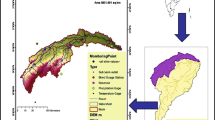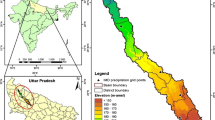Abstract
Modelling streamflow is important in developing effective long-term management, soil conservation planning, and utilization of water resource management strategies. The current study aims to establish a stable hydrological model simulating streamflow with minimal uncertainty amongst the calibration parameters. The SWAT 2012 model is utilized to simulate the Lidder catchment streamflow located in the Southeastern part of the Kashmir valley for the (2007–2015) periods. SWAT- CUP’s algorithm called Sequential Uncertainty Fitting 2 (SUFI-2) is employed in the study for multi-site model calibration and validation for monthly time steps. The calibration results for monthly simulation for the (2009–2012) period displayed an excellent model performance for flow rates with R2 of 0.89, 0.85, and 0.89, and NSE values obtained are 0.73, 0.72, and 0.83. However, the validation results for monthly simulation for the (2013–2015) period also displayed good model performance for flow rates with R2 values obtained as 0.86, 0.81, and 0.80, and NSE values of 0.76, 0.52, and 0.56. Following calibration, the combined impact of each used parameter is ranked by the SWAT-CUP global sensitivity function. A total of twenty parameters are optimized in the calibration. From the study, we find that the most sensitive parameters were Snowfall temperature (SMTMP), Temperature lapse rate (TLAPS), melt factor for snow (SFTMP), and initial SCS curve number value (CN2). Therefore, it is concluded that while developing a reliable hydrologic model, complete knowledge about the hydrological processes occurring within the river basins and awareness of an appropriate and meaningful set of parameters is important.






Similar content being viewed by others
Availability of data
Daily Metrological data were obtained from Indian Meteorological Data (IMD) Pune and measured data of Stages and corresponding discharge for the gauging stations were obtained from the department of irrigation and flood control, Kashmir.
Code availability
Not applicable.
References
Abbaspour KC (2007) User manual for SWAT-CUP, SWAT calibration and uncertainty analysis programs. Eawag: Swiss Fed. Inst. Of Aquat. Sci. and Technol. Dubendorf, Switzerland.
Abbaspour KC, Vejdani M, Haghighat S (2007) SWAT-CUP calibration and uncertainty programs for SWAT. MODSIM 2007 International Congress on Modelling and Simulation, Modelling and Simulation Society of Australia and New Zealand 1596–1602
Abbaspouri KC (2015) SWAT-CUP: SWAT calibration and uncertainty programs—a user manual. Swiss Federal Institute of Aquatic Science and Technology, Eawag, Switzerland
Ambroise B, Beven K, Freer J (1996) Toward a generalization of the TOPMODEL concepts: topographic indices of hydrological similarity. Water Resour Res 32:2135–2145
Andrianaki M, Shrestha J, Kobierska F, Nikolaidis NP, Bernasconi SM (2019) Assessment of SWAT spatial and temporal transferability for a high-altitude glacierized catchment. Hydrol Earth SystSci 23:3219–3232
Arnold JG, Allen PM, Bernhardt G (1993) A comprehensive surface-groundwater flow model. J Hydrol 142:47–69
Arnold J, Moriasi D, Gassman P, Abbaspour K, White M et al (2012) SWAT: model use, calibration, and validation. Trans ASABE 55:1491–1508
Bai J, Shen Z, Yan T (2017) A comparison of single- and multi-site calibration and validation: a case study of SWAT in the Miyun Reservoir watershed, China. Front Earth Sci 11:592–600
Bathurst J, Wicks J, O'Connell P, Singh V (1995) The SHE/SHESED basin-scale water flow and sediment transport modelling system. Comput Models Watershed Hydrol 26:563–594
Bracmort K, Arabi M, Frankenberger J, Engel B, Arnold J (2006) Modeling long-term water quality impact of structural BMPs. Trans ASAE 49:367–374
Braunschweig F, Leitao P, Fernandes L, Pina P, Neves R (2004) The object-oriented design of the integrated water modelling system MOHID. Dev Water Sci 55:1079–1090
ChaibouBegou J, Jomaa S, Benabdallah S et al (2016) Multi-site validation of the SWAT model on the bani catchment: model performance and predictive uncertainty. Water 8:178
Cibin R, Sudheer K, Chaubey I (2010) Sensitivity and identifiability of streamflow generation parameters of the SWAT model. Hydrol Process 24:1133–1148
Duan Y, Liu T, Meng F, Luo M, Frankl A, De Maeyer P, Feng X (2018) Inclusion of modified snow melting and flood processes in the SWAT model. Water 10(12):1715
Easton ZM, Fuka DR, White ED, Collick AS, Ashagre B, McCartney M, Awulachew SB, Ahmed AA, Steenhuis TS (2010) A multi basin SWAT model analysis of runoff and sedimentation in the Blue Nile, Ethiopia. Hydrol Earth SystSci 14:1827–1841
Epelde A, Cerro I, Sánchez-Pérez J, Sauvage S, Srinivasan R, Antigüedad I (2015) Application of the SWAT model to assess the impact of changes in agricultural management practices on water quality. HydrolSci J 60:825–843
Gassman PW, Reyes MR, Green CH, Arnold JG (2007) The soil and water assessment tool: historical development, applications, and future research directions. Trans ASABE 50:1211–1250
Gupta HV, Kling H, Yilmaz KK, Martinez GF (2009) Decomposition of the mean squared error and NSE performance criteria: implications for improving hydrological modelling. J Hydrol 377:80–91
Hasan MA, Pradhanang SM (2017) Estimation of flow regime for a spatially varied Himalayan watershed using the improved multi-site calibration of the Soil and Water Assessment Tool (SWAT) model. Environ Earth Sci 76:787
Holvoet K, van Griensven A, Seuntjens P, Vanrolleghem P (2005) Sensitivity analysis for hydrology and pesticide supply towards the river in SWAT. PhysChem Earth Parts A/B/C 30:518–526
Hosseini SH, Khaleghi MR (2020) Application of SWAT model and SWAT-CUP software in simulation and analysis of sediment uncertainty in arid and semi-arid watersheds (case study: the Zoshk-Abardeh watershed). Model Earth Syst Environ 6:2003–2013
Johanson RC, Imhoff JC, Kittle JL, Donigian AS (1984) Hydrological simulation program-FORTRAN (HSPF): user's manual for release 8.0: EPA- 600/3- 84- 066, USEPA, Athens, Georgia, USA
Kumar N, Singh SK, Srivastava PK, Narsimlu B (2017) SWAT Model calibration and uncertainty analysis for streamflow prediction of the Tons River Basin, India, using Sequential Uncertainty Fitting (SUFI-2) algorithm. Model Earth Syst Environ 3:30
Mehan S, Neupane RP, Kumar S (2017) Coupling of SUFI 2 and SWAT for improving the simulation of streamflow in an agricultural watershed of South Dakota. HydrolCurr Res 8:280
Nash J, Sutcliffe J (1970) River flow forecasting through conceptual models part I—a discussion of principles. J Hydrol 10:282–290
Neitsch S, Arnold J, Kiniry J, Williams J (2011) Soil and water assessment tool: theoretical documentation version 2009. Texas Water Resources Institute
Neupane RP, Kumar S (2015) Estimating the effects of potential climate and land-use changes on hydrologic processes of a large agriculture-dominated watershed. J Hydrol 529:418–429
Neupane RP, Yao J, White JD, Alexander SE (2015) Projected hydrologic changes in monsoon-dominated Himalaya Mountain basins with changing climate and deforestation. J Hydrol 525:216–230
Odusanya AE, Mehdi B, Schürz C, Oke AO, Awokola OS, Awomeso JA, Schulz K (2019) Multi-site calibration and validation of SWAT with satellite-based evapotranspiration in a data-sparse catchment in southwestern Nigeria. Hydrol Earth SystSci 23:1113–1144
Refsgaard J, Storm B (1995) Mike She. In: Singh VP (ed) Chapter 23 in computer models of watershed hydrology. Water Resources Pub, pp 809–846
Saltelli A, Chan K, Marian S (2000) Sensitivity analysis. Wiley, Chichester
Shrestha MK, Recknagel F, Frizenschaf J, Meyer W (2016) Assessing SWAT models based on single and multi-site calibration for the simulation of flow and nutrient loads in the semi-arid Onkaparinga catchment in South Australia. Agric Water Manag 175:61–71
Sloboda M, Swayne D (2011) Autocalibration of environmental process models using a PAC learning hypothesis. Environ Softw Syst Frameworks Environ 329:528–534
Uniyal B, Jha MK, Verma AK (2015) Assessing climate change impact on water balance components of a river basin using SWAT Model. Water Resour Manage 29:4767–4785
Van Griensven A, Meixner T, Grunwald S, Bishop T, Diluzio M, Srinivasan R (2006) A global sensitivity analysis tool for the parameters of multi-variable catchment models. J Hydrol 324:10–23
Williams J, Arnold J, Kiniry J, Gassman P, Green C (2008) History of model development at Temple, Texas. HydrolSci J 53:948–960
Winchell M, Srinivasan R, Di Luzio M, Arnold JG (2013) ArcSWAT interface for SWAT2012: user’s guide. Soil and Water Research Laboratory, USDA Agricultural Research Service
Xuan Y, Cluckie I, Wang Y (2009) Uncertainty analysis of hydrological ensemble forecasts in a distributed model utilizing short-range rainfall prediction. Hydrol Earth SystSci 13:293–303
Yang J, Reichert P, Abbaspour K, Xia J, Yang H (2008) Comparing uncertainty analysis techniques for a SWAT application to the Chaohe Basin in China. J Hydrol 358:1–23
Funding
MHRD, Government of India.
Author information
Authors and Affiliations
Corresponding author
Ethics declarations
Conflict of interest
The authors declare that they have no conflicts of interest.
Additional information
Publisher's Note
Springer Nature remains neutral with regard to jurisdictional claims in published maps and institutional affiliations.
Rights and permissions
About this article
Cite this article
Malik, M.A., Dar, A.Q. & Jain, M.K. Modelling streamflow using the SWAT model and multi-site calibration utilizing SUFI-2 of SWAT-CUP model for high altitude catchments, NW Himalaya's. Model. Earth Syst. Environ. 8, 1203–1213 (2022). https://doi.org/10.1007/s40808-021-01145-0
Received:
Accepted:
Published:
Issue Date:
DOI: https://doi.org/10.1007/s40808-021-01145-0




